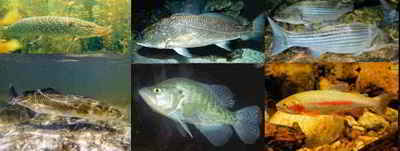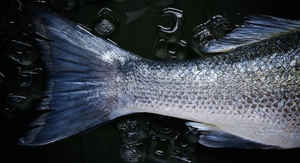Michigan State Fish
Brook Trout

(Salvelinus fontinalis)
Adopted in 1965; February 5, 1988
The trout was designated as the state fish of Michigan in 1965. However, no specific species was designated at that time. In 1988, the Michigan legislature specified the Brook Trout, (Salvelinus fontinalis,) as Michigan state fish. The brook trout is native to Michigan and found throughout the state. The brook trout is olive with lighter sides and a reddish belly (in males) and easily identified by the light colored edges of the lower fins.
The Brook Trout takes first place for the most popular state fish with these states claiming it for their Official State Fish; Maine, Michigan, New Hampshire, New Jersey, New York, Pennsylvania, Vermont, Virginia, and West Virginia. Taken as a whole, trout dominate the Official State Fish category with 18 states calling some type of trout their Official State Fish.
Michigan State Fish: Brook Trout

The average length is 10-12 inches but Brook Trout can be caught measuring up to 21 inches and weighing 4-6 pounds. The largest Brook trout on record was 14.5 pounds and caught in 1916 in the Nipigon River in Ontario. Breeding males develop a hook at the front of the lower jaw. Typical coloring is olive-green to dark brown on the back with silvery sides and pale spotting. All colors intensify at spawning time.
Characteristics of the Brook Trout
Distribution
The brook trout is native to northern North America and is widely distributed throughout the maritime provinces. It occurs in clear, cool, well-oxygenated streams and lakes.
Foods
Brook trout are opportunistic feeders and will eat whatever they can find. In small streams they prefer aquatic insects (nymphs) that live under the rocks and along the stream bottom. They are also known to feed heavily on the adult stage of aquatic insects as they hatch and take flight during their brief courtship and egg laying cycle. Land insects, like ants and beetles, that fall into the water are readily eaten as are small crayfish. They will eat other small fish and minnows but only when they are easy to catch.
Biology
This species spawns in late summer or autumn in gravel beds in the shallows of headwaters of streams. The female digs the redd where she lays 100-5000 eggs depending on her size. They hatch 50-100 days later. The life expectancy is an average of five years. The brook trout is carnivorous and feed upon a wide range of organisms. They have been known to eat their own eggs at spawning time and even their own young.
Michigan Law
The law designating the Brook trout as the official Michigan state fish is Section 2.15 (Brook trout as state fish; use of materials containing reference to trout. ) of the Michigan Revised Statutes, Chapter 2 (State) Section 15 (STATE FISH)
Chapter 2 State
Section 2.15 STATE FISH
2.15 Brook trout as state fish; use of materials containing reference to trout.
Sec. 1.
(1) The brook trout is designated as the official fish of the state of Michigan.
(2) The state shall make use of all materials previously prepared that contain a reference to the trout as the official fish of the state before it
prepares or has prepared new materials that contain a reference to the brook trout as the official fish of the state.
History: 1965, Act 58, Eff. Mar. 31, 1966 ;-- Am. 1988, Act 5, Imd. Eff. Feb. 5, 1988
Taxonomic Hierarchy: Brook Trout
Kingdom: Animalia - animals
Phylum: Chordata - chordates
Subphylum: Vertebrata
Superclass: Osteichthyes - bony fishes
Class: Actinopterygii - ray-finned and spiny rayed fishes
Order: Salmoniformes - salmon and trout
Family: Salmonidae - salmon and trout
Genus: Salvelinus --
Species: Salvelinus fontinalis








